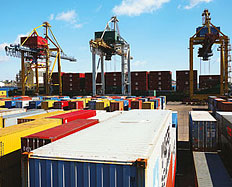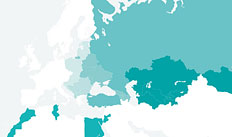COUNTRY ASSESSMENTS
Poland
HIGHLIGHTS OF THE PAST YEAR
- Poland has continued to record strong growth. A soundly supervised banking system and fiscal consolidation have further improved investor risk perceptions and attracted capital inflows into local equity and government bond markets. Weaker indicators in early 2012 have nevertheless led to a significant downward revision in growth expectations.
- The government has initiated important fiscal reforms. These include measures to improve the state pensions system and prevent a further increase in public debt.
- Privatisation volumes have been substantial. The four-year programme to 2011 was met in terms of revenue targets, and a new programme for another 300 companies has been announced. The state’s stake in the country’s largest bank, PKO, has been reduced to a minority one, though the state continues to exercise management control.
KEY PRIORITIES FOR 2013
- A long-standing challenge is to develop more sustainable private financing mechanisms in infrastructure, adopting best practice on public-private partnerships (PPPs). EU structural funds will be more focused and more constrained in future years, in particular given the budget constraints of local governments.
- Links with European parent banks – and close coordination with their supervisors – should be preserved. These links will be increasingly important in light of the current risks to European financial integration, and new institutional mechanisms on bank supervision within the eurozone.
- Local long-term debt funding should be developed further, in particular for banks. Bond market development will require a number of changes in legislation and prudential supervision, for example, in transferring titles for covered bond issuance, and should be supported through the emergence of well‑diversified local institutional investors such as pension funds.
MACROECONOMIC PERFORMANCE
Growth in Poland remained buoyant in 2011 and, although it has slowed in 2012, it remains well above the regional average. Against the headwinds of fiscal consolidation and a slowing EU economy, the Polish economy registered 4.3 per cent growth in 2011. Over the past two years, household consumption and capital investment continued to be the main drivers of growth. The accelerated absorption of EU grant funds and increased infrastructure spending ahead of the 2012 European Championships were key factors behind this success. Since early 2012 exports and industrial production have been slowing markedly, though private consumption, accounting for 61 per cent of GDP, continued to grow at 1.8 per cent in the first half of the year relative to a year earlier. Public investment is expected to fall sharply from the second half of 2012 as fiscal consolidation will significantly weigh on local governments’ capital expenditure, and their capacity to co-finance EU grants, which are about to come to an end under the current budgeting period.
Poland has benefited from strong capital inflows though portfolio investment in the domestic bond markets remained volatile. In 2011 capital inflows were primarily directed into the domestic government bond market, and substantial grant inflows from EU structural funds financed a still sizeable current account deficit (4.9 per cent of GDP last year). In contrast, bank funding showed considerable outflows over the second half of last year, though direct investment within Poland has remained unaffected so far, and the gross FDI inflows of about 3.7 per cent of GDP are relatively high compared with other countries in the region.
The government embarked on a long-delayed fiscal deficit and public debt reduction programme. During the financial crisis of 2009 Poland allowed its fiscal deficit to widen, which mitigated the effects of the crisis. The reduction in the deficit last year stemmed in good measure from the reduction in the contributions into mandatory pension funds, but also from a freeze in the public sector wage bill, and cuts in certain social security expenditures. Following the election in October 2011, the Prime Minister announced a plan to reduce the general government deficit to the Maastricht-compliant level of 3 per cent of GDP in 2012, and then gradually to 1 per cent in 2015, although the 2012 target will be missed given recent growth weaknesses. According to the government’s strategy, public debt is set to stay well clear of the legal limit of 55 per cent of GDP, and should be cut to 47 per cent towards the end of the government’s term in 2015. A more rigorous fiscal rule that will constrain expenditure more tightly from 2015 is under discussion.
MAJOR STRUCTURAL REFORM DEVELOPMENTS
The government initiated a number of fiscal reforms that will have profound implications for public investment. As part of a strengthened legal framework for public finances announced in early 2012, the Finance Ministry set limits on local government deficits. The rule envisages a gradual reduction in the total deficit of local authorities to 0.4 per cent of GDP (from 0.8 per cent last year). Local authorities have been central to the government’s relatively good record in the absorption of EU structural funds, which according to government estimates boosted GDP growth by 0.8 per cent of GDP in 2011. EU structural funds in total represented a net transfer of 2.4 per cent of GDP in 2011, increasing from 0.9 per cent three years previously. A cap on local government deficits may be desirable from the perspective of overall fiscal governance, though it may constrain the co-financing normally mobilised by local authorities, and hence local investment overall.
There has been only limited progress in mobilising private finance for infrastructure through PPPs. In the roads sector two attempts to launch tenders for motorways under the PPP framework were unsuccessful and were cancelled. PPPs encountered major difficulties in relation to open and transparent tendering and during implementation (for example, with regard to land acquisition, cost overruns and lower than expected traffic) which explained a lack of interest from private investors.
The government has begun to tackle the long-outstanding reform of the public pensions system. Following months of difficult public dialogue, in May 2012 parliament adopted an increase in the retirement age. Under this law, starting in 2013, the retirement age will be gradually raised to 67, from the current 60 for women and 65 for men. Labour force participation remains one of the lowest in the EU. Early pension rights for uniformed personnel, a key beneficiary group in the public pension system, will also be restricted. This reform package will begin to address the chronic deficit in ZUS, the state pensions provider, though the longer term demographic challenges are likely to necessitate further reform. The 2011 budget benefited from a considerable reduction in the contributions going into private mandatory pension funds, which will again rise gradually in the period to 2017. In April 2012 the Finance Ministry prepared a plan to partially liberalise the investment allocation restrictions of these private funds and allow the investment of larger shares of portfolios abroad. Also, guarantee requirements that incentivised defensive portfolio allocations have been lifted.
The government, the National Bank, and the financial regulator, KNF, have jointly taken on an agenda to further strengthen the resilience of the financial sector. This includes strengthened macro prudential supervision, following European recommendations in that area, the establishment of a bank resolution regime, and stepped-up bank supervision, in particular with regard to foreign currency mortgages. Given the still dysfunctional inter-bank market, dividend payments, including to these foreign parent banks, have been curtailed. In this area the authorities actively collaborate with other European supervisors, including under the Vienna Initiative. KNF has initiated a number of working groups to develop long-term bond issuance, through the issuance of covered mortgage bonds.
The government announced a new privatisation plan for 2012‑13. Sales of state-owned entities accelerated under the previous programme in the four years to 2011, over which about PLN 50 billion or 3.3 per cent of 2011 GDP in privatisation revenues has been raised. Nevertheless, these were primarily small stakes, and key sectors such as petrochemicals, other energy, and chemicals remain state‑dominated. Further ownership transformation is now targeted for 300 companies, though in about 45 important companies (mainly in the energy, finance and defence sectors) majority stakes will be retained. According to this plan, the government will seek to raise innovation the potential and competiveness, exercise more active supervision, and attract more innovative financing. Privatisation revenues may partly be directed to a reserve fund for the public pensions system and into the Fund for Polish Science and Technology. The programme also mentions potential benefits of the development of local capital markets, and of Warsaw as a regional financial centre, given the likely higher stock exchange capitalisation and market turnover. The sale in July 2012 of a 7.8 per cent state stake in PKO BP, the country’s largest bank, was a notable step in this agenda and reduced the state’s share to less than an outright majority. The management of the bank, however, continues to be appointed by the state as the largest shareholder.
The government seeks to further reduce administrative barriers to enterprises. The 2012 World Bank’s Doing Business Report showed a slight decline in Poland’s relative ease of doing business ranking (to 62nd place out of 183 countries worldwide), and the low score (relative to most EU countries) is, in a large part, due to barriers to starting a business and tax administration. According to the Polish Confederation of Private Employers, the main obstacle for business growth is the overregulated labour code that makes it difficult to increase employment. Following re-election, the government re‑launched a programme that aims to gradually reduce regulations on more than 200 professions. A number of measures were also adopted in 2011 with a view to reduce red tape for business, for instance, through greater scope for self-certification.







